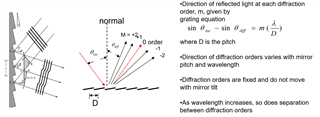I have a new question.
When I irradiate laser beam, the reflection beam spread in a strange way.
Is that OK? Then, the surface of DMD is no matter. If the surface image change, the
spread direction is not changed. Please see the picture.
Is it the bragg reflection .or other diffraction ?
(the laser wavelength is 532nm, power is much low.)




